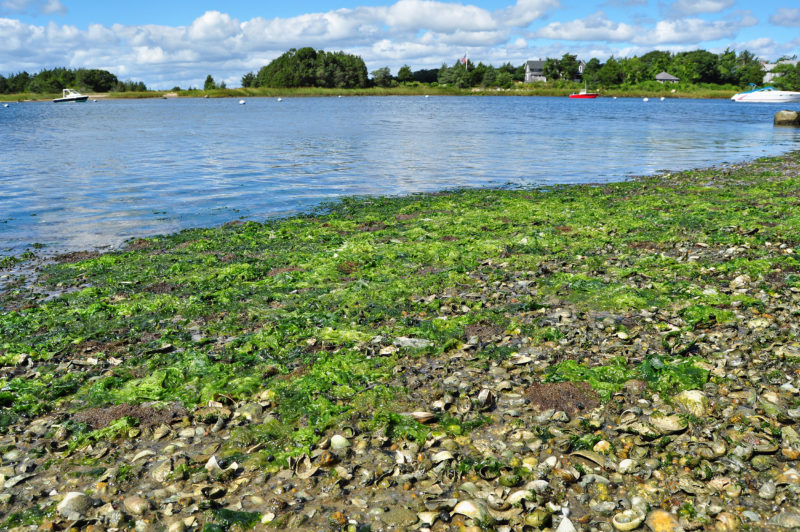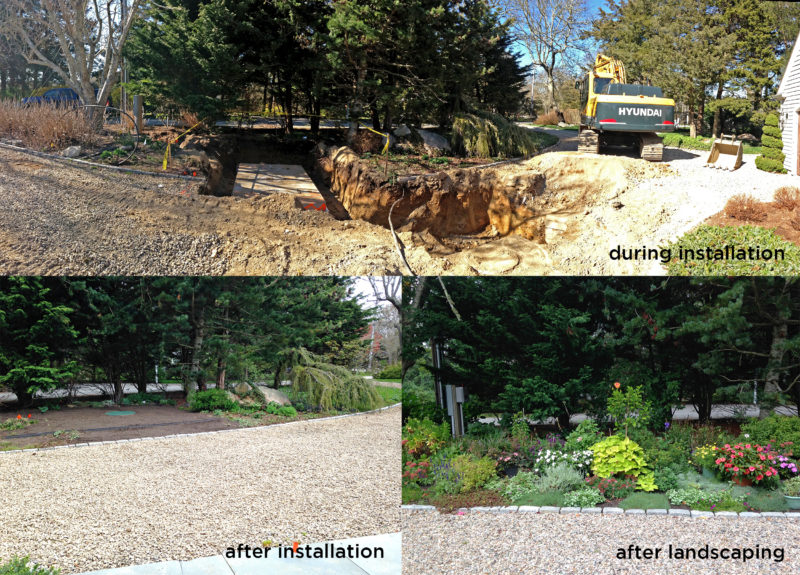West Falmouth demonstration project reduces nitrogen pollution from 20 septic systems by 78%
Last year, 20 homeowners around West Falmouth Harbor signed up to upgrade their septic systems or cesspools to nitrogen-reducing technology as part of a demonstration project led by the Coalition and the town of Falmouth. These 20 upgraded systems are already reducing nitrogen by at least 78% – making a difference to help speed up the harbor’s recovery.

Nitrogen pollution fuels the growth of algae, which can wash up on beaches as slimy green muck.
West Falmouth residents have watched the health of their harbor worsen over the past few decades due to nitrogen pollution from wastewater. Nitrogen fuels the growth of algae that makes the water cloudy and covers beaches and boats with slimy green muck. Because of nitrogen pollution, the harbor’s underwater eelgrass beds have died and fish and shellfish populations have slowly disappeared.
In 2008, the U.S. EPA approved a federal pollution limit called a TMDL for West Falmouth Harbor. At that time, the largest source of nitrogen to the harbor was the town’s wastewater treatment facility, which was upgraded a few years later after the state set a strict limit on the amount of nitrogen that it could discharge into the harbor.
But even with this upgrade, the harbor’s nitrogen limit won’t be met without reducing nitrogen from septic systems, which today make up the largest source of this harmful type of pollution. All of the homes that line West Falmouth Harbor use on-site septic systems or cesspools, which do not remove nitrogen from treated wastewater.
In 2015, the Coalition and its project partners – the town of Falmouth, the West Falmouth Village Association, and the Barnstable County Department of Health and Environment – set out to learn whether West Falmouth homeowners could retrofit their existing septic systems and cesspools with nitrogen-reducing technology. As an incentive, the project offered a $10,000 subsidy to homeowners who were willing to participate.
Within a year, new state-of-the-art septic systems were being installed at 20 homes around the harbor. The lessons learned about site design, engineering, permitting, approvals, installation, and costs are collected in a new report from the Coalition: West Falmouth Nitrogen-Reducing Septic System Demonstration Project: May 2017 Status Report. (This report will be updated in 2018 with a full year’s worth of monitoring data from these 20 systems.)

Although septic system installation was invasive during construction (top), contractors and homeowners found innovative ways to keep the systems out of sight, but still accessible for monitoring. At this home, the homeowners used landscaping to hide the cover of their new Eliminite system in the driveway garden (bottom photos).
This demonstration project made it clear that it’s possible to retrofit on-site septic systems with state-of-the-art nitrogen-reducing septic technology. There are many different types of nitrogen-reducing technologies available today – which was not the case even a few years ago. The larger challenge is finding the cheapest option that works for each unique home site. There are many factors that influence the cost of these upgrades, including geology, utilities, the amount of time per year the home is used, and proximity to wetlands.
After homeowners learned about the most popular nitrogen-reducing technologies, they selected four: two proprietary systems, Eliminite and Hoot, and two non-proprietary systems, blackwater and layered soil treatment (“layer cake”). The average cost to add nitrogen reduction to a conventional Title 5 system was $20,417, while full upgrades from old cesspools cost an average of $33,225.
The success of this project has led to a Phase II project, which will upgrade 10 more septic systems in 2017 with a $7,500 subsidy for each participating homeowner. That’s in addition to another septic system upgrade project, which will test 12 new “layer cake” systems in communities around Buzzards Bay. These projects provide a model that can be used in other neighborhoods to upgrade septic systems and reduce nitrogen pollution.
Solving the Bay’s nitrogen pollution problem will only happen when we upgrade septic systems like these 20 homeowners did. The West Falmouth demonstration project helps point the way forward for homeowners, town officials, and septic installers to take action to save Buzzards Bay for future generations.